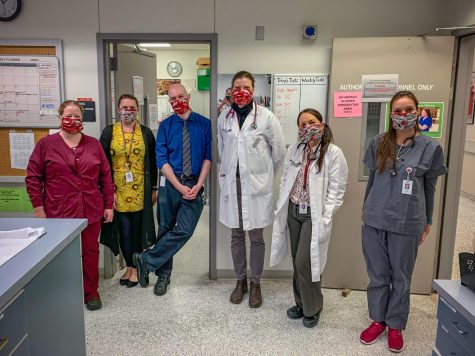Veterinary hospital receives about 1,000 face masks
Retirees, Washington healthcare staff sew, donate masks; one local gives out ear savers
Staff members at the WSU VTH have to work in close proximity with each other while operating on injured and sick animals.
July 19, 2020
For the doctors and staff at the WSU Veterinary Teaching Hospital, wearing a mask all day and working in close proximity is part of the job description.
People have donated masks to the VTH when it sent out a request for 250-400 masks at the beginning of the pandemic. About 100 staff and doctors were working at the time. The VTH asked for more masks when its students came back in June, said Dr. Debra Sellon, VTH director and veterinarian.
So far, the VTH has received about 1,000 masks. The masks come in different sizes, colors and styles. Everyone has been able to choose a mask that fits their needs. They can even choose a mask that matches their outfit, Sellon said.
Retiree Judy Dettinger is one of the many people who donated to the hospital.
“The Washington State veterinary program was a great help to our family when we had cats,” Dettinger said. “Our cats lived to be 15, 18 and 19, and they all had separate, specific diseases that were rather unusual.”
She appreciated what the VTH did for her cats and family so much that Dettinger said she even donated the cats’ bodies to the hospital.
Dettinger learned that the VTH requested masks through a NextDoor newsletter post that Cheri Brennan, WSU alumna, had posted. Dettinger had already made and donated masks to places like EvergreenHealth hospital.
She knew she had to sew some masks for the VTH when she saw the post, Dettinger said. She donated 14 masks.
Liz Yamamoto, home health speech therapist, has also been involved with the VTH, leading her to donate 150-200 masks to the hospital. For two to three years, she had her dog donate blood so dogs that needed it could get a blood transfusion.

Through that experience, she worked closely with some of the WSU staff. She also went to the teaching hospital when her other dog injured his knee, requiring two knee surgeries in three months.
“I was really involved with [the] WSU veterinary program, and so when I started donating masks and making masks, [the VTH was] just one of the obvious ones that I would put on my list to add to the rotation to donate to,” Yamamoto said.
Pediatric Trauma Therapist Allison Heber was not planning to donate masks to the VTH, but when Brennan approached her about making WSU-themed masks and even went so far as to get her WSU fabric, Heber said she was able to sew and donate 27 masks.
Heber said she had been making masks since the beginning of the pandemic when masks were difficult to come by and could take ages to get.
“It started as just like, ‘Oh, I’ll sew some masks for my family.’ And then somebody said ‘Where’d you get that mask?’” Heber said. “And I was like, ‘Oh, I can make some for you.’ And then word just kind of spread and it kind of has become what I do every day.”
Retiree Sharon Cousins made and donated 24 ear savers to the VTH.
“From what I hear from the ER nurse across the road from me, everybody’s ears are getting sore,” she said.
Ear savers also improve the fit of the mask, Cousins said. As someone who does not sew well, she was happy to look into another way to help.
Typically, ear savers have normal buttons on them, but they move around and do not hold firm, she said.
One day, she realized why normal buttons did not work, Cousins said. She worked with Jacob Rember, a Moscow open-source maker, who helped her develop the new button using laser cutting, she wrote in an email.
The traveling ER nurse that lives across the street from Cousins takes her ear savers to hospitals, and people like them so far.
“So I thought of our vets at the school and hospital who have been putting out the call for any kind of face masks they can get and figuring a lot of them they’re getting are elastic because a lot of them are made with elastic. I bet they could use some good ear savers,” Cousins said.
Sellon said the VTH is grateful for all the donations. Last fiscal year alone, the hospital had more than 20,000 patient visits. The doctors see large and small animals alike, and oftentimes, people must work closely together to treat an animal.
“I knew that we had a lot of people who really strongly support what we do in the community, and I was hopeful that we could get what we needed because those people care about animals just as much as we do,” Sellon said.









Sharon Cousins • Jul 20, 2020 at 1:58 pm
Very nice story on our amazing and heartwarming local maker efforts!